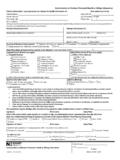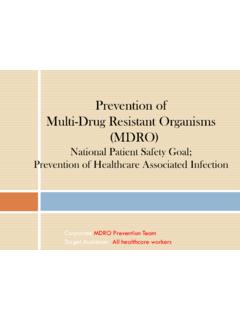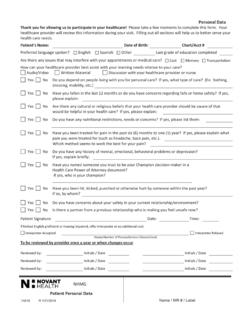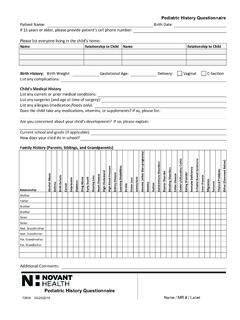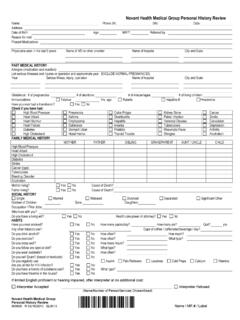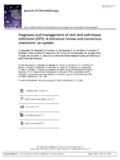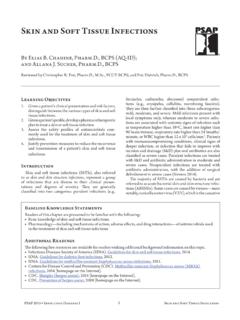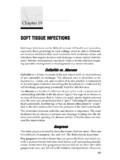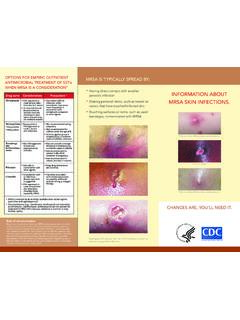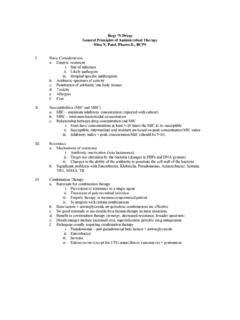Transcription of PREVENTION OF SURGICAL SITE INFECTIONS - Novant …
1 PREVENTION OF SURGICAL site INFECTIONS Corporate SSI PREVENTION Team Target Audience: All healthcare workers who are taking care of patients before, during and after surgery Course Navigation Advance through the course using the navigation bar on the bottom of the screen. Just click the forward button (shown below) Learning Outcomes At the end of this session the attendee will be able to: 1. List at least 3 SURGICAL site infection risk factors each which are either patient related, procedure related, or operating room related 2.
2 Discuss basic practices that all acute care hospitals can use to reduce SURGICAL site INFECTIONS 3. Identify at least 3 PREVENTION measures which can be monitored for compliance SURGICAL site INFECTIONS SURGICAL site INFECTIONS lead to increased morbidity, mortality, length of stay, and cost for many SURGICAL patients each year. Education on risk factors and compliance with PREVENTION measures may lead to decreased INFECTIONS in the SURGICAL patient. Collaboration between Infection Preventionist and staff can lead to a shared vision of increased patient safety.
3 Types of SURGICAL site INFECTIONS (SSI) Incisional Superficial SSI- occurs within 30 days after surgery and involves skin or subcutaneous tissue Deep SSI occurs within 30 days after surgery and involves deep soft tissue (fascia & muscle) Organ Space occurs within 30 days after surgery if no implant or within 1 year if implant is placed and involves any part of the anatomy ( organs, spaces) other than the incision which was opened or manipulated during the surgery. CDC Definition of SSI The Guideline for PREVENTION of SURGICAL site Infection, 1999 Consequences of SURGICAL site INFECTIONS SURGICAL site INFECTIONS (SSIs) result in up to $10 billion in costs every year.
4 The patient infected with a SURGICAL site infection: - Is hospitalized 7 days longer. - Is 60% more likely to spend time in the ICU. - Is 5 times more likely to be readmitted within 30 days of discharge. - Is twice as likely to die. SURGICAL Risk Factors that Influence development of SSI Duration of scrub skin antisepsis SURGICAL attire Sterile draping Duration of surgery Wound class Prophylaxis Traffic in the OR Temperature and Humidity Glucose control of the patient Temperature control of the patient Foreign materials SURGICAL drains SURGICAL technique Other Risk Factors of SSI Compromised state of health prior to surgery, chronic illnesses, unhealthy lifestyle and advanced age.
5 Most INFECTIONS are caused by germs found on and in a patient's body that enter SURGICAL site . Outside sources of contamination- SURGICAL personnel, SURGICAL environment, instruments and air. Calculating Risk of SSI The dose of bacteria present multiplied by the aggressiveness of the bacteria divided by patients immune status equals the risk of development of an SSI. PREVENTION - Gloves Gloves reduce transmission of pathogens on the hands but do not provide complete protection. Gloves may contain small defects. When integrity of gloves is compromised, change immediately.
6 Gloves may swell, expand and loosen from absorption of fluid and fat. Use of petroleum-based hand lotions or creams may adversely affect the integrity of latex gloves. The use of gloves does not replace the need for hand washing and/or hand sanitizer use. Pre-operative PREVENTION of SSI-Patient Education Optimize health- Control risk factors such as excess weight, malnutrition, hypertension, weakened immune system, smoking, and uncontrolled diabetes. Bathing prior to surgery A preoperative antiseptic shower or bath decreases skin microbial colony counts.
7 Assess for other INFECTIONS - such as UTI, skin INFECTIONS , dental INFECTIONS , etc. Pre-operative PREVENTION of SSI- Patient Preparation Meticulous Hand Hygiene skin preparation- to remove harmful bacteria Adhere to appropriate scrub and drying times Clean gown and head covering Hair removal- In many cases, hair removal is not necessary. When required, single use head clippers are to be used. No shaving. Razors leave microscopic cuts on the skin that are all potential entry points for bacteria. PREVENTION skin Preparation- the goal is to remove as much potential harmful bacteria as possible.
8 Patients are colonized with bacteria, fungi, and viruses up to 3 million germs per square centimeter of skin . Hand Hygiene Appropriate SURGICAL techniques- the types of incisions made, the amount of manipulation of the tissue required, the amount of time the procedure takes and the technique used to close the incision can increase or reduce the risk of infection. Avoid flashing of SURGICAL instruments Intra-operative PREVENTION of SSI- SURGICAL Attire Head Covering Wear a cap or hood to fully cover hair on the head and face. Hospital provided scrubs.
9 Mask- Wear a SURGICAL mask that fully covers the mouth and nose when entering the OR sterile hallway or OR room. Remove when surgery is complete and discard in trash. Shoe covers Eye Shield- when splatter is anticipated. Intra-operative PREVENTION of SSI- Controlling OR Traffic Each person entering OR brings in additional skin flora and increases the risk of contamination. Opening and closing of doors causes air currents to swirl and potentially sweep in bacteria from outside the OR. 15 air exchanges can not be maintained to ensure clean air and removal of bacteria.
10 PREVENTION of SSI- Room and Equipment Cleaning Clean OR between each procedure Terminal cleaning daily is critical in preventing health care associated INFECTIONS . Dust contains human skin and hair, fabric fibers, pollens, mold, fungi, glove powder and paper fibers. Disinfect non critical equipment Equipment should be disassembled, cleaned, disinfected, cleaned with an EPA-registered disinfectant and dried before reuse and/or storage. Sterilization of Critical equipment/ supplies High level disinfection For some surgeries, one of the ways to prevent SURGICAL site INFECTIONS (SSI) is by giving patients antibiotics 0 to 60 minutes (for usual antibiotics) or 0 to 120 minutes (Vancomycin or Fluroquinolones) before surgery.

